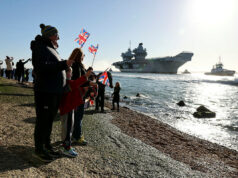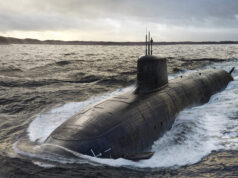The fully reconfigurable Australian Research Experimental Submarine (ARES) will be used for hydrodynamic and crew efficiency testing of future submarine designs.
A full business case is still being finalised ahead of the kick-off meeting in Adelaide, South Australia, in February.
The project is collaboration between the University of Adelaide, University of South Australia, Flinders University, TAFE SA and the University of Tasmania’s Australian Maritime College with Defence support from DST Group.
The four industry partners for the project are SAAB, ASC, Dassault Systemes and MOOG Australia.
ARES received $150,000 in Defence Innovation Partnership funding from the South Australian Government last month to boost a $350,000 in kind contribution from participants to fund the project’s first year. An estimated $3 million will be needed to complete the three-year project. Project lead and University of Adelaide Director of the Shipbuilding Hub for Integrated Engineering and Local Design (SHIELD) Eric Fusil said the project would deliver Australia’s first reconfigurable research submarine.
He said the autonomous submarine would be used to test hydrodynamics – how a submarine behaves underwater – to aid in the design and safe operation of new submarines globally.
“Because you can’t see on board a submarine and you don’t really know where you are going, you need to know that when you are pulling on the controls from inside the submarine that you are setting the control planes outside at a given angle. You need to know the effect of these angles for each given speed on the trajectory of the submarine – otherwise you are at risk of breaching the surface or diving too quickly.
Despite all our best efforts worldwide we’re still at a point where we cannot use computers to predict all of that. You need to go to actual testing with small-scale submarines to be able to deliver a safe analysis of how present or future submarines are behaving underwater. These vehicles are often quite specific to a class of submarine whereas our submarine will have the ability to be generic and to be adaptable to any kind of shape overall and also to any kind of location of contour plane.”

Early designs show the submarine to be about 7-metres long and up to 1.8m high. Its ‘golden wattle’ yellow colour will allow it to be easily observed during underwater tests.
Initial testing will likely be done in lakes at a depth of 30-40m – deep enough to properly test the submarine’s hydrodynamics but shallow enough for it to be safely recovered by dive teams if it encounters problems.
While Australia has not previously had a research experimental submarine, several of its allies including the United States, United Kingdom, The Netherlands and France have used them extensively. Fusil said the project would also help develop a skilled workforce that will go on to contribute to Australia’s future submarine program.
“The project is quite unique because in Australia so far we have taken products off the shelf and we have customised and adapted them to our Australian environment,” he said.
“On this project we are starting pretty much from scratch but we have access to a very good technical support network including UK, The Netherlands and potentially the French so we will be able to feed on the lessons learned from these countries and take the best from all of them to build a successful model.”
The project will also enlist the help of several international ‘Grey Beards’, experienced industry experts who will mentor and guide the project.
The first year of the project will mainly involve design work before procurement, manufacture and testing phases in years two and three.
Fusil said DST Group – the Australian government’s Defence Science Technology agency and one of the project’s major partners – would have the opportunity to use ARES to help develop the Attack Class submarine and also to validate other projects Australia is involved in with its allies.
“Our aim – because we are universities with industries and DST – is to start with an unclassified submarine shape but we want that shape to be able to be used by our sponsors such as DST for classified testing if they elect that to be the case,” he said.
“But we are also aware there is a niche market for these vehicles. Because submarines are being considered by many navies including in the Southeast Asian region, there are a number of countries that are interested in accessing this kind of technology. We could export that vehicle because it is based on an unclassified shape and it can be customised we could sell this kind of free-running model to our neighbouring countries interested in having their own model to be used for analysis to develop their own submarines.”














Being a suspicious sort of cuss, my first thought was that this is a big investment when the Aussies are unlikely to build submarines without foreign assistance. Maybe there are other uses that they have in mind for which this is just a cover?
There has been a lot of political controversy over Australia’s choice for their next submarine, particularly in relation to the pump jet propeller vs the more conventional design. Pump jet works well on the nuclear subs it was designed for as they patrol at high speeds. On an AIP sub which Australia has selected the cruising speeds are much slower therefore the propeller will be louder than the conventional design.
AIP was controversial in its own right as it will take the subs over 3 weeks to reach the south China sea. All for double the cost of the Virginia class SSN’s
About 6 months ago Japan announced that it’s next submarine design is expected to use pumpjet propulsion:
https://www.navyrecognition.com/index.php/news/defence-news/2019/july/7250-japan-begins-development-of-its-next-gen-attack-submarines-the-29ss.html
It was a poor choice. AIP isn’t the alternative to nuclear as some think. The Japanese are getting better results with bigger generator sets and using more lithium batteries.
To me they caught between two different needs. The South China Sea though important now in a war with China (say) would be less important than defending the seas between Oz and Indonesia coupled with RAAF assets for sea denial. And then they have the vast distances of the Indian Ocean to consider. To my mind they need two classes. Ideally something akin the SAAB A-26 (as an example). That would give them common systems for a smaller boat for operations around the islands and as I said a bigger boat for the Indian Ocean.
I think the expansion of number of hulls is very ambitious. Especially on top of their large OPV procurement programme which I think they will find useful (larger hulls always are)
but if push comes to shove will be just sitting ducks in a peer to peer conflict. A class of patrol frigate couple with a 1000 ton vessel class would probably have served them better and a replacement for the Armidales (more Bays?). Twelve 1800 tonne OPV’s? I don’t know.
Those rear shots are a lil revealing……
Wouldn’t be a bad idea for the USN or the RN to loan a decomming LA or Trafalgar (with appropriate crew) to the RAN to practice long term underwater deployments and develop skills needed for the new SSKs that the current Collins class can’t provide. Those SSNs still have plenty of life for that type of mission.
Cheers
$3 million is an amazingly small amount of money for a defence research project. The UK should get involved and throw a few pennies in too.